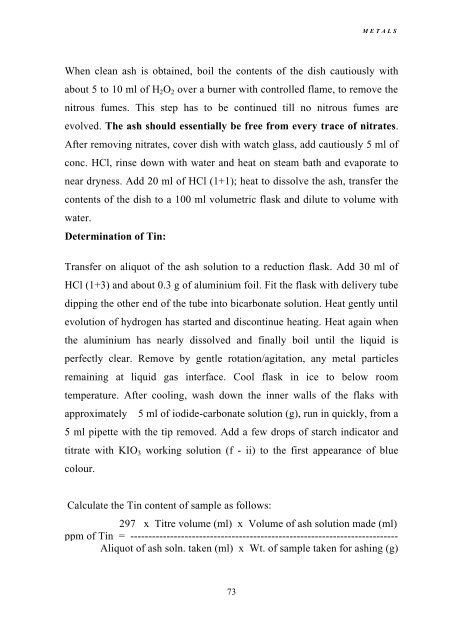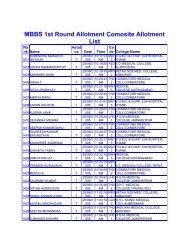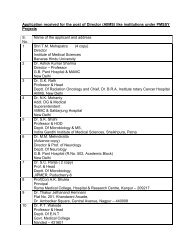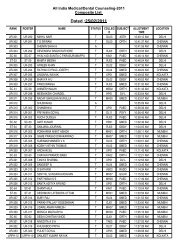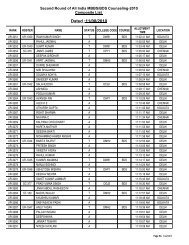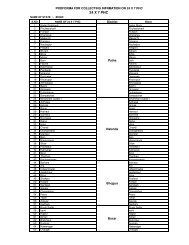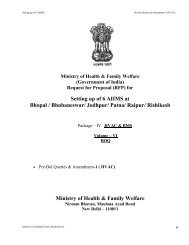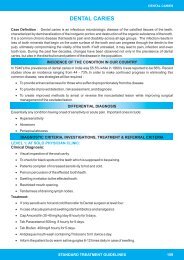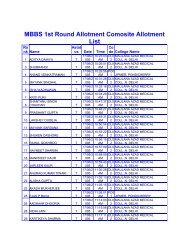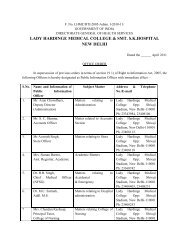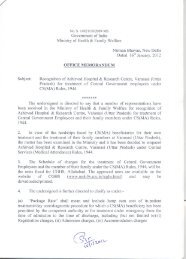manual of methods of analysis of foods - Ministry of Health and ...
manual of methods of analysis of foods - Ministry of Health and ...
manual of methods of analysis of foods - Ministry of Health and ...
Create successful ePaper yourself
Turn your PDF publications into a flip-book with our unique Google optimized e-Paper software.
METALS<br />
When clean ash is obtained, boil the contents <strong>of</strong> the dish cautiously with<br />
about 5 to 10 ml <strong>of</strong> H 2 O 2 over a burner with controlled flame, to remove the<br />
nitrous fumes. This step has to be continued till no nitrous fumes are<br />
evolved. The ash should essentially be free from every trace <strong>of</strong> nitrates.<br />
After removing nitrates, cover dish with watch glass, add cautiously 5 ml <strong>of</strong><br />
conc. HCl, rinse down with water <strong>and</strong> heat on steam bath <strong>and</strong> evaporate to<br />
near dryness. Add 20 ml <strong>of</strong> HCl (1+1); heat to dissolve the ash, transfer the<br />
contents <strong>of</strong> the dish to a 100 ml volumetric flask <strong>and</strong> dilute to volume with<br />
water.<br />
Determination <strong>of</strong> Tin:<br />
Transfer on aliquot <strong>of</strong> the ash solution to a reduction flask. Add 30 ml <strong>of</strong><br />
HCl (1+3) <strong>and</strong> about 0.3 g <strong>of</strong> aluminium foil. Fit the flask with delivery tube<br />
dipping the other end <strong>of</strong> the tube into bicarbonate solution. Heat gently until<br />
evolution <strong>of</strong> hydrogen has started <strong>and</strong> discontinue heating. Heat again when<br />
the aluminium has nearly dissolved <strong>and</strong> finally boil until the liquid is<br />
perfectly clear. Remove by gentle rotation/agitation, any metal particles<br />
remaining at liquid gas interface. Cool flask in ice to below room<br />
temperature. After cooling, wash down the inner walls <strong>of</strong> the flaks with<br />
approximately 5 ml <strong>of</strong> iodide-carbonate solution (g), run in quickly, from a<br />
5 ml pipette with the tip removed. Add a few drops <strong>of</strong> starch indicator <strong>and</strong><br />
titrate with KIO 3 working solution (f - ii) to the first appearance <strong>of</strong> blue<br />
colour.<br />
Calculate the Tin content <strong>of</strong> sample as follows:<br />
297 x Titre volume (ml) x Volume <strong>of</strong> ash solution made (ml)<br />
ppm <strong>of</strong> Tin = --------------------------------------------------------------------------<br />
Aliquot <strong>of</strong> ash soln. taken (ml) x Wt. <strong>of</strong> sample taken for ashing (g)<br />
73


